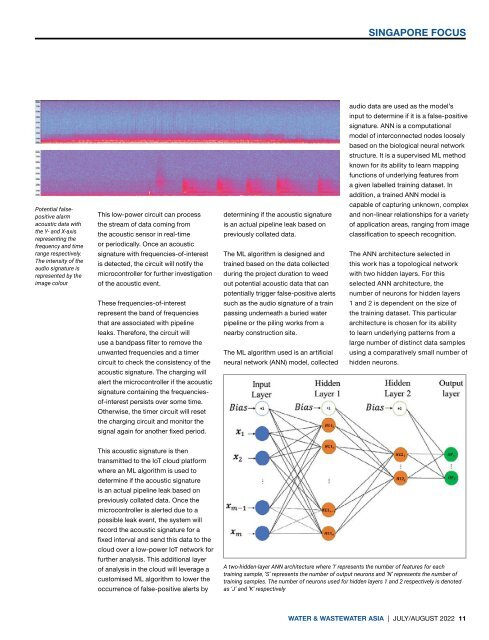Water & Wastewater Asia July/August 2022
Water & Wastewater Asia is an expert source of industry information, cementing its position as an indispensable tool for trade professionals in the water and wastewater industry. As the most reliable publication in the region, industry experts turn this premium journal for credible journalism and exclusive insight provided by fellow industry professionals. Water & Wastewater Asia incorporates the official newsletter of the Singapore Water Association (SWA)
Water & Wastewater Asia is an expert source of industry information, cementing its position as an indispensable tool for trade professionals in the water and wastewater industry. As the most reliable publication in the region, industry experts turn this premium journal for credible journalism and exclusive insight provided by fellow industry professionals. Water & Wastewater Asia incorporates the official newsletter of the Singapore Water Association (SWA)
Create successful ePaper yourself
Turn your PDF publications into a flip-book with our unique Google optimized e-Paper software.
SINGAPORE FOCUS<br />
audio data are used as the model’s<br />
input to determine if it is a false-positive<br />
signature. ANN is a computational<br />
model of interconnected nodes loosely<br />
based on the biological neural network<br />
structure. It is a supervised ML method<br />
known for its ability to learn mapping<br />
functions of underlying features from<br />
a given labelled training dataset. In<br />
addition, a trained ANN model is<br />
Potential falsepositive<br />
alarm<br />
acoustic data with<br />
the Y- and X-axis<br />
representing the<br />
frequency and time<br />
range respectively.<br />
The intensity of the<br />
audio signature is<br />
represented by the<br />
image colour<br />
This low-power circuit can process<br />
the stream of data coming from<br />
the acoustic sensor in real-time<br />
or periodically. Once an acoustic<br />
signature with frequencies-of-interest<br />
is detected, the circuit will notify the<br />
microcontroller for further investigation<br />
of the acoustic event.<br />
These frequencies-of-interest<br />
represent the band of frequencies<br />
that are associated with pipeline<br />
leaks. Therefore, the circuit will<br />
use a bandpass filter to remove the<br />
unwanted frequencies and a timer<br />
circuit to check the consistency of the<br />
acoustic signature. The charging will<br />
alert the microcontroller if the acoustic<br />
signature containing the frequenciesof-interest<br />
persists over some time.<br />
Otherwise, the timer circuit will reset<br />
the charging circuit and monitor the<br />
signal again for another fixed period.<br />
determining if the acoustic signature<br />
is an actual pipeline leak based on<br />
previously collated data.<br />
The ML algorithm is designed and<br />
trained based on the data collected<br />
during the project duration to weed<br />
out potential acoustic data that can<br />
potentially trigger false-positive alerts<br />
such as the audio signature of a train<br />
passing underneath a buried water<br />
pipeline or the piling works from a<br />
nearby construction site.<br />
The ML algorithm used is an artificial<br />
neural network (ANN) model, collected<br />
capable of capturing unknown, complex<br />
and non-linear relationships for a variety<br />
of application areas, ranging from image<br />
classification to speech recognition.<br />
The ANN architecture selected in<br />
this work has a topological network<br />
with two hidden layers. For this<br />
selected ANN architecture, the<br />
number of neurons for hidden layers<br />
1 and 2 is dependent on the size of<br />
the training dataset. This particular<br />
architecture is chosen for its ability<br />
to learn underlying patterns from a<br />
large number of distinct data samples<br />
using a comparatively small number of<br />
hidden neurons.<br />
This acoustic signature is then<br />
transmitted to the IoT cloud platform<br />
where an ML algorithm is used to<br />
determine if the acoustic signature<br />
is an actual pipeline leak based on<br />
previously collated data. Once the<br />
microcontroller is alerted due to a<br />
possible leak event, the system will<br />
record the acoustic signature for a<br />
fixed interval and send this data to the<br />
cloud over a low-power IoT network for<br />
further analysis. This additional layer<br />
of analysis in the cloud will leverage a<br />
customised ML algorithm to lower the<br />
occurrence of false-positive alerts by<br />
A two-hidden-layer ANN architecture where ‘I’ represents the number of features for each<br />
training sample, ‘S’ represents the number of output neurons and ‘N’ represents the number of<br />
training samples. The number of neurons used for hidden layers 1 and 2 respectively is denoted<br />
as ‘J’ and ‘K’ respectively<br />
WATER & WASTEWATER ASIA | JULY/AUGUST <strong>2022</strong> 11


















